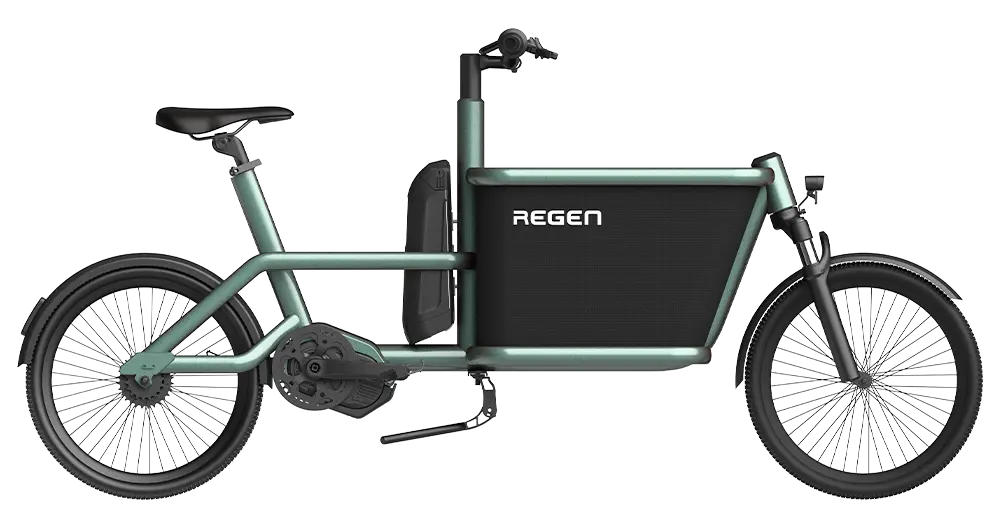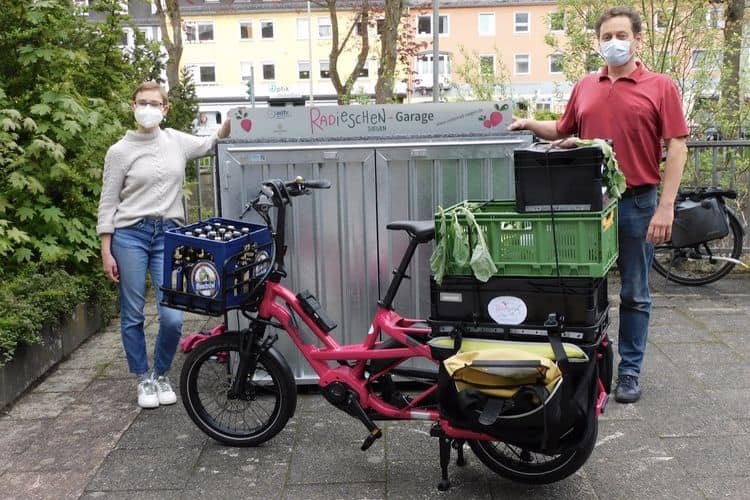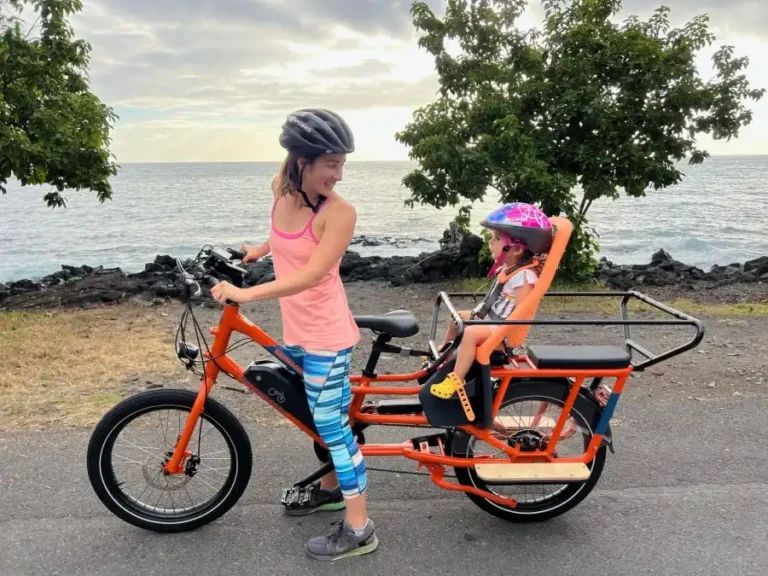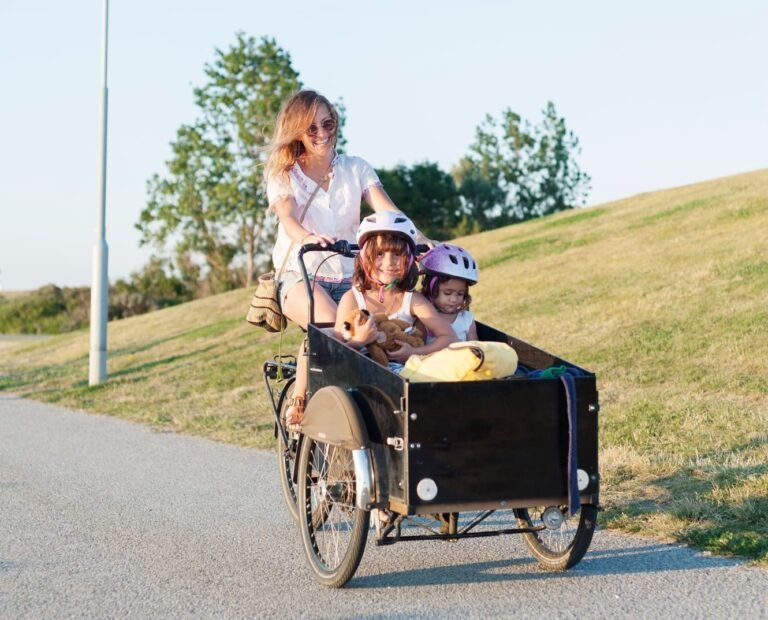En Regen, donde diseñamos y fabricamos sistemas completos de bicicletas de carga para familias y flotas, a menudo nos preguntan por la iluminación delantera, sobre todo cuando los ciclistas empiezan a desplazarse al anochecer, a recorrer callejones urbanos con poca luz o a hacer entregas en rutas rurales más oscuras. La iluminación no es sólo una cuestión de visibilidad, sino también de legalidad vial, seguridad del ciclista e incluso eficiencia de la batería.
En esta guía, respondemos a las preguntas más habituales sobre las luces delanteras para bicicletas de carga, desde cuántos lúmenes necesitas realmente hasta si 4000 lúmenes es excesivo, todo ello respaldado por normas y casos de uso reales.
¿Qué es una luz delantera en una bicicleta de carga?
A luz delantera cargo bike es un dispositivo de iluminación orientado hacia delante que se monta en el manillar, la corona de la horquilla o el portaequipajes. Está diseñado para:
- Iluminación activa (para iluminar el camino del jinete)
- Visibilidad pasiva (para alertar a los demás de tu presencia)
A diferencia de las bicicletas de paseo básicas, las bicicletas de carga pueden transportar pasajeros o mercancías, y a menudo funcionan con cargas y velocidades más elevadas. Esto hace que una iluminación frontal fiable no sólo sea útil, sino esencial para legalidad vial y seguridad de los motoristas.
| Factor | Uso urbano | Uso rural o sendero | Bicicletas de carga |
|---|---|---|---|
| Lúmenes | 300-500 | 800-2000+ | 500-1500 |
| Patrón del haz | Ancho, corto | Largo y concentrado | Ancho + medio |
| Montaje | Manillar | Horquilla / Casco | En horquilla o integrado en el bastidor |
| Tipo de batería | USB recargable | Mochila externa de gran capacidad | Integrado con la batería principal (para bicicletas eléctricas) |
Para las bicicletas de carga, recomendamos un haz gran angular que ilumina tanto la carretera como los laterales, especialmente con un cuadro delantero largo que puede proyectar sombras. Las luces integradas que se alimentan de la batería principal de la e-bike ofrecen fiabilidad y comodidad.
¿Es realmente necesaria una luz delantera en una bicicleta?
Sí, tanto desde el punto de vista legal como práctico, una luz delantera es esencial.
- Requisitos legales: En la mayoría de los países de la UE y en el Reino Unido, es obligatorio llevar una luz delantera blanca cuando se circula de noche o en condiciones de baja visibilidad (se aplican la norma EN 15194 y los códigos de circulación locales).
- Necesidad práctica: Permite que otros usuarios de la carretera te vean y te ayuda a ver la carretera por delante, especialmente baches, bordillos o escombros, algo especialmente importante en una bicicleta de carga cargada.
Caso real: Los repartidores urbanos suelen informar de que, sin una luz delantera adecuada, la visibilidad disminuye en más de 50% tras la puesta de sol, incluso en calles bien iluminadas.
¿Es necesaria una luz delantera en una bicicleta de carga?
Sí, en la mayoría de los países europeos y en el Reino Unido, las luces delanteras son obligatorias por ley para bicicletas utilizadas de noche o con poca visibilidad.
Según Normativa europea EN 15194 (para bicicletas de pedaleo asistido eléctricamente):
- A luz delantera blanca o amarilla selectiva debe estar instalado.
- La luz debe ser visible desde al menos 100 metros.
- Para su homologación en carretera, el haz luminoso no debe deslumbrar a los demás usuarios de la vía pública (haz de cruce).
En Alemania, el StVZO (Straßenverkehrs-Zulassungs-Ordnung) exige una conformación del haz, un brillo y una estabilidad de la fuente de alimentación específicos, especialmente para las bicicletas eléctricas.
¿De qué color debe ser la luz delantera de una bicicleta?
El color correcto para una luz delantera es:
Amarillo selectivo (menos común, se utiliza en condiciones de niebla o bajo contraste)
Blanco (más común y legal en todas las regiones)
Las normativas de la UE y del Reino Unido (EN 15194, StVZO en Alemania, Road Vehicles Lighting Regulations en el Reino Unido) especifican que la luz delantera debe emitir una luz fija o intermitente. rayo blanco.
Importante: Las luces azules o de colores en la parte delantera suelen ser ilegales y pueden confundirse con vehículos de emergencia o causar problemas de visibilidad a otros usuarios de la carretera.
Consejo: Las luces de color blanco cálido (temperatura de color 4000-5000K) son más cómodas para la conducción nocturna en comparación con los LED de tonos azules intensos.
¿Cuántos lúmenes debe tener una luz delantera de bicicleta?
La luminosidad se mide en lúmenesque cuantifican la cantidad total de luz visible emitida.
| Situación de conducción | Lúmenes mínimos recomendados |
|---|---|
| Visibilidad diurna (modo intermitente) | 200-300 lúmenes |
| Circular de noche por la ciudad | 400-600 lúmenes |
| Carreteras rurales o sin alumbrado | 800-1500 lúmenes |
| Descenso a alta velocidad / carga pesada | 1500-2000+ lúmenes |
Para bicicletas de cargaPor lo general, recomendamos 600-1200 lúmenesen función de:
- Si conduces de noche
- Condiciones de iluminación de las carreteras
- Velocidad y peso de la carga (que afectan al tiempo de parada)
Consejo profesional: Elige una luz con brillo regulable (por ejemplo, bajo-medio-alto) para equilibrar el consumo de energía y la visibilidad.
¿1000 / 3000 / 4000 lúmenes son demasiados para una luz de bicicleta?
Depende, pero sí puede ser demasiado brillante en algunas condiciones.
| Nivel de lumen | Caso de uso | ¿Demasiado brillante? |
|---|---|---|
| 1000 lúmenes | Excelente para bicicletas de carga y uso general | ✅ Seguro e ideal |
| 3000 lúmenes | Adecuado para todoterrenos o zonas muy oscuras | ⚠️ Riesgo de deslumbrar a los demás |
| Más de 4000 lúmenes | Brillo extremo; uso MTB o trail | 🚫 Excesivo para el uso en carretera. |
Por qué el brillo excesivo puede ser un problema:
- Deslumbra a los ciclistas o conductores que circulan en sentido contrario
- Puede infringir las normas legales en lugares como Alemania (las luces que cumplen la normativa StVZO limitan la intensidad del haz).
- Desperdicia energía: agota más rápido la batería de la e-bike o el paquete de luz externo.
Solución: Busque luces con lentes antideslumbrantes o un haz de corte: dirigen la luz hacia abajo, iluminando la carretera sin deslumbrar a los demás.
Tipos de Bicicleta de carga Luces delanteras por fuente de alimentación
| Tipo | Descripción | Adecuado para |
|---|---|---|
| Funciona con pilas | Pila de iones de litio integrada, recargable por USB | Montajes ligeros, uso urbano ocasional |
| Dinamo | Alimentación por concentrador, eficiencia energética, autonomía infinita | Bicicletas utilitarias, sin necesidad de recarga |
| Sistema de bicicleta eléctrica | Conectado a la batería principal de la e-bike a través del controlador | La mayoría de las bicicletas de carga modernas con batería central |
Características adicionales que debe tener la luz delantera de una bicicleta de carga
- Sistema de montaje integrado: Especialmente importante para bicicletas de carga frontal. Una luz montada en la horquilla o integrada en el portaequipajes reduce las vibraciones y mejora la estabilidad del haz.
- Grado de impermeabilidad: Al menos IPX4 para desplazamientos lluviosos.
- Modo de conducción diurna: Mejora la visibilidad a la luz del día, cada vez más frecuente en las flotas de reparto de mercancías.
- Integración de la batería: Para las bicicletas eléctricas de carga, lo ideal es una luz delantera que se alimente de la batería principal de la bicicleta: menos componentes que cargar o gestionar.
- Función de luz de posición: Algunas dinamos de alta gama o luces integradas permanecen encendidas durante unos minutos después de parar - útil para semáforos en rojo o paradas cortas.
Normas legales y de seguridad a tener en cuenta
Cuando compre o integre un sistema de luces delanteras, compruebe que cumple:
- EN 15194 - La normativa europea sobre seguridad de las bicicletas eléctricas incluye requisitos de iluminación
- StVZO - Norma alemana de alumbrado vial (si exporta o vende en Alemania)
- ONU ECE R113 - Para la distribución del haz de luz y la dispersión de la luz, especialmente relevante para los vehículos eléctricos más grandes.
- RoHS / CE - Seguridad de los componentes eléctricos y cumplimiento de la normativa medioambiental

Bicicleta de carga eléctrica Regen 02
¿Busca una lavadora de carga frontal compacta y personalizable para su marca?
Probado por TÜV en proyectos personalizados anteriores. Modelo disponible públicamente: configurable, probado y listo para escalar.
¿Cómo debe ser una buena luz delantera para bicicleta de carga?
Una buena luz delantera de bicicleta de carga es crucial para la seguridad, especialmente dado el tamaño típicamente más grande y las cargas más pesadas de las bicicletas de carga. Aquí tienes un desglose de lo que hace que una luz sea eficaz:
1. Brillo (Lumen/Lux de salida):
- Lúmenes altos: Las bicicletas de carga necesitan una potencia luminosa considerable para iluminar el camino, sobre todo cuando transportan cargas pesadas que pueden oscurecer la carretera o cuando circulan por zonas con alumbrado público limitado. Mientras que para las bicicletas normales se suele citar un mínimo de 100-200 lúmenes, las bicicletas de carga se benefician enormemente de una mayor potencia, a menudo del orden de 1.000 lúmenes. Gama de más de 500-1000 lúmenesespecialmente para carreteras o caminos sin iluminar. Algunas luces específicas para e-bikes pueden llegar hasta los 1.800 lúmenes o más.
- Lux frente a lúmenes: Mientras que los lúmenes miden la potencia luminosa total, los luxes miden la intensidad de la luz a una distancia y en una zona determinadas. Las luces diseñadas con un buen patrón de haz (ver más abajo) pueden tener menos lúmenes pero seguir proporcionando una iluminación excelente donde más se necesita gracias a los lux optimizados.
2. Patrón del haz:
- Extensión amplia y uniforme: A diferencia de las bicicletas de carretera, que podrían beneficiarse de un haz más concentrado para la velocidad, las bicicletas de carga necesitan un haz amplio y uniforme para iluminar la zona más amplia delante de la bicicleta, incluida la zona de carga y los posibles obstáculos a los lados.
- Haz de corte (conforme a StVZO): Las luces con un haz de corte horizontal son muy recomendables, especialmente si circula entre el tráfico. Este diseño dirige la luz hacia la carretera y evita cegar a los ciclistas y conductores que circulan en sentido contrario. Se trata de una característica común en las luces que cumplen la normativa europea (StVZO).
- Sin puntos calientes: Un buen haz de luz debe ser suave y uniforme, sin "puntos calientes" demasiado brillantes que puedan crear sombras y reducir la visibilidad general.
3. Fuente de alimentación y tiempo de funcionamiento:
- Funciona con pilas (recargables): Muchas luces modernas para bicicletas de carga son recargables por USB. Busque tiempos de ejecución largos, especialmente si hace paseos prolongados u olvida cargar con frecuencia. USB-C es un cómodo estándar de carga.
- Accionado por buje dinamo: Para una mayor comodidad y una iluminación "siempre encendida", un buje dinamo integrado en la rueda delantera es una opción excelente. Genera energía mientras conduces, eliminando la necesidad de cargar la batería. Es especialmente popular en las bicicletas de carga europeas.
- E-Bike Integrado: Si tiene una bicicleta eléctrica, busque luces diseñadas para integrarse directamente en el sistema de baterías de su bicicleta eléctrica. Estas luces suelen ofrecer una potencia más alta y constante sin necesidad de baterías independientes. Asegúrese de que el voltaje de la luz coincide con el sistema de su bicicleta eléctrica (por ejemplo, 12 V, 24 V, 36 V, 48 V).
4. Opciones de montaje:
- Seguro y estable: Las motos de carga suelen sufrir más vibraciones e impactos más fuertes. La luz debe montarse de forma segura para soportar estas fuerzas y mantener su objetivo.
- Colocación adecuada: Considere dónde se montará la luz en su bicicleta de carga específica. Algunas bicicletas de carga tienen puntos de montaje específicos, mientras que otras pueden requerir soluciones creativas. Un punto de montaje más alto suele mejorar la visibilidad del conductor y de los demás usuarios de la carretera.
- Despejado: Asegúrate de que la luz no interfiere con la carga, la dirección u otros accesorios.
5. Durabilidad y resistencia a la intemperie:
- Construcción robusta: Una luz de bicicleta de carga debe estar hecha para durar, con una carcasa duradera (a menudo de aluminio) para soportar el uso diario y los posibles golpes.
- Impermeable/Resistente a la intemperie: Busca una clasificación IPX4 o superior para asegurarte de que la luz resiste la lluvia y las salpicaduras.
6. Características adicionales:
- Múltiples modos: Aunque un haz potente y constante es esencial para ver, los modos intermitentes pueden aumentar tu visibilidad ante los demás durante el día o en entornos urbanos con mucho tráfico. Algunas luces también ofrecen un modo "adaptativo" que ajusta el brillo en función de la luz ambiental.
- Luz de conducción diurna (DRL): Los estudios demuestran que el uso de luces durante el día puede reducir significativamente el riesgo de colisiones. Un modo DRL específico, a menudo un destello menos intenso pero muy visible, es una característica valiosa.
- Visibilidad lateral: Las luces con recortes laterales o LED adicionales orientados hacia los lados pueden mejorar la visibilidad desde ángulos distintos al frontal, lo que es importante para la seguridad en los cruces.
- Funcionalidad Power Bank: Algunas linternas a pilas también funcionan como bancos de energía, lo que permite cargar el teléfono u otros dispositivos sobre la marcha.
- Interfaz de usuario sencilla: Los botones sencillos y fáciles de usar con guantes y la selección clara de modos son un plus.
¿Dónde debe montarse el faro delantero?
Una colocación correcta garantiza la seguridad y evita las sombras. Estas son las opciones más comunes:
| Posición de montaje | Ventajas | Contras |
|---|---|---|
| Manillar | Fácil de instalar y ajustar | Puede crear sombras hacia delante si la carga obstruye |
| Corona de horquilla | Iluminación constante, poco deslumbramiento | Puede temblar en terreno accidentado |
| Portacargas o tubo frontal | Se alinea con la altura de la carga | Requiere soportes a medida |
Para bicicletas de carga frontal, las luces del manillar pueden ser insuficientes. A menudo recomendamos sistemas de iluminación dual:
- Luz primaria encendida portaequipajes o bastidor
- Luz secundaria encendida manillar
Cómo Regen Ayudas: Iluminación modular, alimentación integrada y conformidad
Diseñamos las bicicletas de carga Regen teniendo en cuenta la integración de la iluminación:
- Montaje de luces a medida para Long Johns, trikes y step-throughs
- Cableado estanco (IP65+) y mazo de cables prefundido
- Gestión de la alimentación del sistema para evitar que se agote la batería
- Opciones conformes con StVZO y EN 15194 para clientes de la UE
- Opcional DRL, conmutación de luces largas/cortas, y sensores de luz automáticos
Y para los socios OEM/ODM, ofrecemos integración de luces delanteras a medida en función de la geometría de la montura, la estética de la marca y las situaciones del usuario.
📩 Póngase en contacto con nosotros para hablar de su proyecto.
Referencias
- Comité Europeo de Normalización (CEN). (2021). EN 15194: Requisitos de seguridad y métodos de ensayo.
- Ministerio Federal de Transporte e Infraestructura Digital (Alemania). (2022). StVZO - Straßenverkehrs-Zulassungs-Ordnung.
- Estudio sobre patrones y seguridad de los haces luminosos de las bicicletas - Federación Alemana de Ciclistas (ADFC), 2020.






